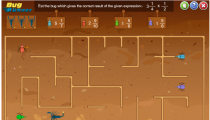The frog life cycle is fascinating to both kids and…

Teaching Kids the Steps of the Water Cycle Through Video
 Learning about nature is something that is really exciting and fun for kids, and getting a good understanding of basic climate and biology principles is a fundamental part of science for any elementary school student. Using videos really makes the weather, climate and habitat information come alive for kids, giving them an in depth look at these things that they can’t get from books alone!
Learning about nature is something that is really exciting and fun for kids, and getting a good understanding of basic climate and biology principles is a fundamental part of science for any elementary school student. Using videos really makes the weather, climate and habitat information come alive for kids, giving them an in depth look at these things that they can’t get from books alone!
Using a water cycle video for kids brings it alive for them, and after all this cycle is a moving thing, not something static in nature. In fact one of the hallmarks of the natural world is how dynamic and changing it is. The evaporation cycle is one of the first scientific concepts that kids are introduced to that explores the changing nature of, well, nature!
When watching the video, be sure to talk to kids about what they’re seeing. Don’t hesitate to rewatch it several times, discussing their questions and reactions. While video is often a passive experience, it doesn’t have to be! In order to get kids to really understand, teachers and parents stop and ask questions, and also invite kids to ask questions.
Reinforcing the Concept
After watching the video, it’s important that kids get extra reinforcement in order to remember the steps of the water cycle. Remember that you can always come back to the water cycle video and watch again to help jog their memory!
A key step on the road to mastery is to kids get comfortable with the vocabulary of science. Have kids repeat the following vocabulary words from the video in order to make sure that they have a good understanding of each one, and ask them to explain the definition of each in their own words:
- Evaporation
- Ocean
- Stream
- River
- Lake
- Waterfall
- Water Vapor
- Condensation
- Liquid
- Gas
- Water Droplets
- Surface Runoff
Once kids know the words, it’s time to really deepen that understanding. Here are some great reinforcing activities to help kids explore.
- Create a page in their science or exploring journal.
- Have kids draw their concept of the cycle on blank paper, having older kids label each part.
- Use online quizzes to determine how well kids grasp the concept, then come back and fill in the gaps with activities or by re-watching the video.
- Have children repeat the keywords
- Write or draw the steps of the cycle on cards and have kids arrange them in the proper order.
- Go outside and look up at the sky and the ground. Talk about how this concept is found in the real world, reinforcing how it works outside of the classroom. Be sure to have kids reference the material from the video!
- Play online games about the evaporation cycle, which will allow kids to explore science in a really fun and engaging format.
Hands On Activities
In addition to exploring science through the video, worksheets and practice, teachers and parents can reinforce the steps of the through hands on activities.
- Create an evaporation window experiment by putting a handful of garden soil in a sandwich sized clear zip bag, sprinkling it with water (just a sprinkle, too much won’t work!) and taping it to a sunny window. Then have kids observe the bag at different times of day and tell what steps of the cycle they see.
- Create “weather in a cup” using this great activity.
- Make a small terrarium out of a clear plastic food container and observe how the water moves. Fill the bottom with a layer of dirt, then add some rocks, living vegetation (moss, a clump of grass, etc.), and a shallow pool of water using a smaller container. Don’t put much water in the pool, as part of the experiment is to observe how the water evaporates. Once all of these are inside, place your terrarium in the sun and observe how the water moves over the course of several days. Then ask the following questions:
- What happened to the water from the pool?
- How does the rock react to the water?
- How does the dirt react to the water?
- How does the plant react to the water?
- Which part of the terrarium represents the clouds? The ocean? The land?
Be sure to watch the video again together before you explore the results of these hands on activities, which will help your child relate what they learned to what they’re observing. In fact many of the activities listed here are great to do again and again!
Science is at it’s core about exploration, something that kids are experts at. Using video and other interactive tools, kids find confidence in their ability to explore scientific principles like evaporation, runoff and cloud formation.





